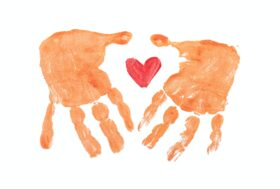Developing mathematical graphics in the Early Years

- Early Years |
- Maths |
- Pedagogy
Young children’s graphical representations are as valuable to mathematical learning as their early mark-making is to their writing development (Carruthers and Worthington, 2011). They support deep-level learning and provide an important foundation for the future. In this article, we explore the development of children’s mathematical graphics in the Early Years, how this can be supported by practitioners and how the secure use of standard symbols can emerge from and alongside this.
Graphical representations assist children on their mathematical journey
Personal recording and jottings are important in mathematics at all ages. They help us to organise and track our thoughts, enhancing our mathematical thinking and ability to solve problems. Children’s early marks are often referred to as ‘mathematical graphics’ (a term popularised by Worthington and Carruthers, 2003). In mathematical mark-making, the number of marks can be significant, as well as their shape, position and orientation. The marks act as a record to ‘hold’ and express thoughts as we engage in mathematics, and the process is therefore crucial. A final record of four balls in a basket may show four lines, for example, but the child’s process might have been writing two, then one more, then another.
Children’s representations of numbers, shapes, patterns or operations need not always be on paper: children can make mathematical marks on a range of surfaces, including log slices, pavements, walls, trays and whiteboards. Children have increasing opportunities for mark-making with technology in early mathematics (e.g. the curricula described by Clements and Sarama, 2021). Such devices may facilitate learning by removing the need for manual dexterity, while perhaps reducing some variety but increasing speed and the amount of mark-making that children can perform (Price et al., 2015).
In the earliest stages, children make deliberate marks as they enjoy experimenting with different tools, surfaces and media. They explore the cause and effect of their actions, trialling different actions to create a range of marks. For very young children, this can be indistinguishable from emergent writing, in that the meaning that the child associates with their marks may be quantities, shape, pattern, words, actions or images. As mark-making develops, the distinction between which marks the child intends to represent words and those that have a more mathematical meaning becomes clearer to the adults who know them well, and ‘marks’ at the later stages include symbols and drawings.
Children’s engagement with mathematical graphics over time supports them to develop effective learning habits or dispositions in mathematics. In creating mathematical graphics, children develop characteristics of effective learning, defined in England (DfEDepartment for Education - a ministerial department responsible for children’s services and education in England, 2021a, p. 16) as:
- ‘playing and exploring – children investigate and experience things, and “have a go”’: openly exploring informal, individual mark-making that is voluntary and low-stakes
- ‘active learning – children concentrate and keep on trying if they encounter difficulties, and enjoy achievements’: showing high levels of involvement and sustaining concentration on a mathematical activity for longer because of their ownership over the process; they are experts in their own representations
- ‘creating and thinking critically – children have and develop their own ideas, make links between ideas, and develop strategies for doing things’: they make decisions about what symbols or marks to use and how to arrange these, determining for themselves what is important to record and how; this might be different to how others choose to represent the mathematics (including adults) and may include more efficient representations over time.
As children move through school, the balance will shift from informal to more formal methods of recording, but informal methods are not redundant. For all children, they can continue to be a useful stepping stone to learning a new written algorithm or a way of checking an answer or making sense of a new problem. Mark-making for older children can take the form of jottings. Where value is placed on informal jottings and space is provided to make them, this can reduce the pressure on working memory. Jottings support organisation and being systematic, as well as encouraging risk-taking to try out methods about which the child is less certain.
Practitioners support an apprenticeship approach to using numerals and standard symbols
Research is clear that understanding formal representations of mathematics is not easy for young learners but, in the words of Martin Hughes (1986, p. 34), ‘we can help children build meaningful links between the world of written symbols and the world of concrete reality’.
Hughes found that children who had been taught standard numerals, addition and subtraction symbols and equations often failed to use these when representing on paper a quantity or a change in quantity. It is important for children to learn standard written notation. These develop as ‘informal marks [which] are gradually transformed into standard symbolism’ (Worthington and Carruthers, 2003, p. 77). We expose children to numerals alongside developing their confidence in making their own mathematical marks, so they can begin to appreciate the benefits of number symbols as efficient tags for amounts. The move from informal to formal can be seen as a shift in balance, where children continue to use their own jottings and these sit alongside standard ways of representing as their recording gradually adopts standard written forms (Gifford, 1997). This takes time. We cannot underestimate the leap of understanding and the depth and range of experience that contribute to a child being able to confidently make one mark, such as ‘5’ to stand for five separate objects. Children are apprenticed into the way in which numbers are culturally represented, as well as developing a repertoire of ways of expressing themselves (Ewers-Rogers, 2002).
It is important to use graphics and manipulatives alongside standard notation and verbal explanation until at least six years, and not rely on standard notation alone. Dowker (2005) found striking differences between the ages of four and six years in children’s ability to interpret addition and subtraction problems presented in standard notion. Older children do not always link standard notation to concrete representations and need to continue to use manipulatives and jottings, being explicitly encouraged to link these to the standard notation (Fuson, 1986; Hart, 1989).
Practitioners support children’s graphical representations through talk, gesture, play and story contexts
Mathematical ideas need to make personal sense. Mathematical graphics offer opportunities for this personal sense-making by providing a conceptual link between practical exploration and symbolic representation. The child is not providing a copy of the real-world objects but a representation of ‘their interactions with the object’ (Fosnot and Dolk, 2001, p. 78). Figure 1 shows a subtraction interaction with the hand taking away two cars (Davenall, 2016). The dynamic element is captured through the graphic.

Talking with children about their graphical representations encourages child talk and allows them to rehearse their ideas. Mathematical graphics provide adults with an insight into the child’s mathematical understanding if we watch and listen as children create graphics and ask them to interpret them for us. Children, as the experts in their own thinking, are able to help adults to understand their mathematical thinking through their graphics. Talking with children also often leads to the use of gesture and action, as children explain how they combined two quantities, for example. This is particularly powerful where the dramatic action of a story holds significant value for children, leading to heightened emotion and energy in the children’s explanations. Contexts that are meaningful for the child (and part of their world) are powerful.
Pretend play is a rich context for mathematical mark-making. Finding ways of writing price labels for shop items and till receipts for items sold is a purposeful and meaningful context in which to write numbers. A six-year-old in charge of the charity shop role-play area can price items in whole pounds, for example, allowing them to successfully manage the addition of two or three items.
Recording a journey or a route, in pretend play or when out and about, allows for representation of position, direction and location. This can provide valuable opportunities for early map-making, which involves routes, perspective and scale. Children’s recording of their block play is fascinating in showing how they perceive individual and grouped blocks within their construction and how they represent their three-dimensional model in two dimensions. For example, in Figure 2, a four-year-old has represented the three walls of their construction, paying careful attention to the shape of the blocks, the number of layers and the position of the people.


Figure 2: Block play with small figures (four-year-old)
Conclusion
The depth of understanding that children gain through their mathematical graphicacy provides a strong foundation for future mathematical learning in three ways. Firstly, children build new knowledge by connecting and adapting existing understanding to deep understanding, where children can use and apply knowledge flexibly, providing a secure and stable basis for future learning. Secondly, deep understanding gained through mark-making enables children to work autonomously, secure in the knowledge that they can record their process in a way that is meaningful to them. This allows them to check and track back, promoting confidence and resilience. It helps them to feel like mathematicians, as insiders and not outsiders in the world of school mathematics. Thirdly, mathematical mark-making enables adults to access children’s mathematical thinking, in that there is a record of thinking that can be shared and discussed. Early valuing of mark-making makes children more willing to show their working as they get older. Making mathematical thinking visible in this way enables their teachers to pinpoint errors or difficulties and, crucially, see how the child has approached a problem, knowing where teaching of more efficient methods is needed.
In this article, we have summarised the case for valuing, encouraging and supporting mathematical graphics in the Early Years. Clearly, this is an ongoing endeavour for us as practitioners and something that we weave into our mathematical provision and practice. It is helpful that there is explicit recognition of the importance of mathematical mark-making in ‘Development matters’ (DfE, 2021b, p. 89), where there is encouragement for children to ‘experiment with their own symbols and marks’, as well as in ‘Birth to 5 matters’ (Early Education, 2021), where adults are encouraged to model, talk about and provide tools for this.
If we accept that all young children are able to think deeply about and be proficient in mathematics, which is the underlying principle at the heart of learning and teaching for mastery, then encouraging and supporting children’s own emerging mathematical graphics is one way of enriching and deepening children’s understanding. If we wish our teaching to build on what children know and can do mathematically, children’s informal mathematical graphics provide a window into their thinking and a means to build secure understanding of mathematical symbols. As Herbert Ginsburg (2021) points out:
‘If children get off on the wrong symbolic foot, the result may be a nasty fall down the educational stairs.’
References
- Carruthers E and Worthington M (2011) Understanding Children's Mathematical Graphics: Beginnings in Play. Maidenhead: McGraw-Hill Education.
- Clements DH and Sarama J (2021) Learning and Teaching Early Math: The Learning Trajectories Approach, 3rd ed. New York: Routledge.
- Davenall J (2016) Young children’s mathematical recording. Available at: https://nrich.maths.org/12384 (accessed 14 June 2022).
- Department for Education (DfE) (2021a) Statutory framework for the Early Years Foundation Stage. Available at: www.gov.uk/government/publications/early-years-foundation-stage-framework--2 (accessed 14 June 2022).
- Department for Education (DfE) (2021b) Development matters: Non-statutory curriculum guidance for the Early Years Foundation Stage. Available at: https://assets.publishing.service.gov.uk/government/uploads/system/uploads/attachment_data/file/988004/Development_Matters.pdf (accessed 14 June 2022).
- Dowker A (2005) Individual Differences in Arithmetic: Implications for Psychology, Neuroscience and Education. Hove: Psychology Press.
- Early Education (2021) Birth to five matters. Available at: www.birthto5matters.org.uk (accessed 14 June 2022).
- Ewers-Rogers J (2002) Very young children’s understanding and use of numbers and number symbols. PhD Thesis, University of London Institute of Education, UK.
- Fosnot CT and Dolk M (2001) Young Mathematicians at Work: Constructing Number Sense, Addition and Subtraction. Portsmouth NH: Heinneman.
- Fuson K (1986) Roles of representation and verbalization in the teaching of multi-digit addition and subtraction. European Journal of the Psychology of Education 1: 35–56.
- Gifford S (1997) When should they start doing sums? A critical consideration of the ‘emergent mathematics’ approach. In: Thompson I (ed) Teaching and Learning Early Number. Buckingham: Open University Press.
- Ginsburg H (2021) What children know and need to learn about counting. Available at: https://prek-math-te.stanford.edu/counting/what-children-know-and-need-learn-about-counting (accessed 14 June 2022).
- Hart K (1989) There is little connection. In: Ernest P (ed) Mathematics Teaching: The State of the Art. London: Falmer, pp. 138–142.
- Hughes M (1986) Children and Number: Difficulties in Learning Mathematics. Oxford: Basil Blackwell.
- Price S, Jewitt C and Crescenzi L (2015) The role of iPads in pre-school children's mark making development. Computers and Education 87: 131–141.
- Worthington M and Carruthers E (2003) Children’s Mathematics: Making Marks, Making Meaning. London: Paul Chapman Publishing.











I love the idea of valuing children’s mark making. It is a really great tool for practitioners as well to get a sense of their mathematical processes. And valuing that mark making is an inclusive practise. No child is left out because their markings don’t resemble another’s.
Thank you
What a fantastic read, I have noticed the importance and mathematical journey children take. How different stages lead to a wide range of areas.